Selecting Evergreen Trees
"Evergreen" refers to plants that normally retain most of their foliage through the winter. When evergreen trees are mentioned, the pines, plants belonging to the genus Pinus with needle-like leaves often leaves often are thought of, but there are other types of evergreen plants such as junipers with scale- or awl-like leaves and cherrylaurel with broad leaves.
Even though evergreen trees retain their foliage year-round, they do not retain all their leaves indefinitely. For example, southern magnolia, a broadleaf evergreen, and loblolly pine, a needle-leaf evergreen, usually drop leaves that are three years old each year. These older leaves are the innermost ones toward the main trunk. Younger leaves, further out on the branch, are retained until they are three years old. This annual browning and drop of innermost, older needles can cause concern, but it is a natural process.
Evergreen trees lend year-round interest, color and texture to the landscape. They can help define your garden space by providing structure which can serve as the backdrop for other plants. This structure is the secret to a beautiful winter garden. Evergreen trees are versatile and can be used as specimens, hedges, privacy screens or windbreaks. They also can be used for sound-reducing purposes, wildlife shelters and shade.
Because there are so many evergreen trees for use in landscaping, carefully select plants appropriate for your needs. Selection should be based on several different factors such as intended purpose, environmental conditions and maintenance requirements.
The intended purpose should influence selection of plants with appropriate shape,
size and other physical characteristics. Consider the size of mature trees and where
they are to be used. Trees that grow tall, such as the loblolly pine, are suitable
for larger buildings and spaces. They tend to dominate or hide one-story buildings.
For attractive and proper balance with one-story buildings, choose trees more in scale
with the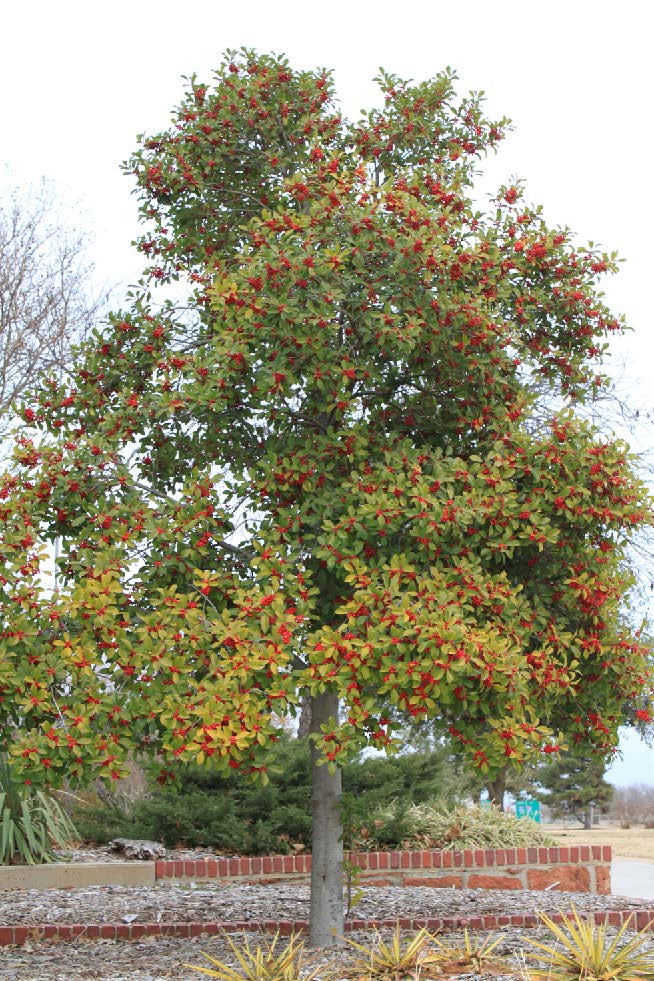 building size. Careful consideration of mature size will reduce the need for pruning.
building size. Careful consideration of mature size will reduce the need for pruning.
Environmental conditions also should influence the selection of plants. Site characteristics such as sunny or shady, wet or dry, exposure to winter winds or pollution are important. Plants selected should be tolerant of existing conditions and be cold and heat hardy in the Oklahoma climate.
Finally, consider how much maintenance the plant will require and any possible disadvantages including susceptibility to attack by disease and insect pests, soft or brittle wood that is easily damaged by wind and ice, fruits and seeds that are large, messy or otherwise obnoxious and abundant shedding of twigs and small branches. Plants that may exhibit these types of characteristics can still be used but should be carefully placed. Pictured is a Foster Holly tree in the winter.
Trees recommended in the next sections are merely examples of what grows well in Oklahoma. Lists provided are not comprehensive, but are to assist the homeowner in working with their local horticulturists and professionals. Some plants mentioned may not be suited for all landscape situations but are intended to fill specific needs in the landscape. Sometimes a compromise in plant selection may be necessary for the specific purpose to be realized.
When "spp." is used in a name, it implies multiple species and or hybrids are available. Plants with an asterisk, while a desirable species, may not be found in all nurseries or garden centers; however, a nursery professional can suggest viable substitutes with similar attributes or possibly special order the tree. In some cases, these trees may be found and ordered online.
Planting for a Purpose
Tolerates or Prefers Dry Locations
Most or all of the trees listed below will still require vigilant irrigation for at
least the first growing season. Upon establishment, plants below are known to tolerate
or even prefer dry sites. Tolerance of dry or xeric conditions will widely differ
amongst these species, sometimes at the expense of optimal/showy foliage and overall
aesthetic attributes. Appropriate mulching also bolsters a tree's tolerance to dry
soils. Pictured below is the Horstmann blue atlas cedar (Cedrus atlantica 'Horstmann').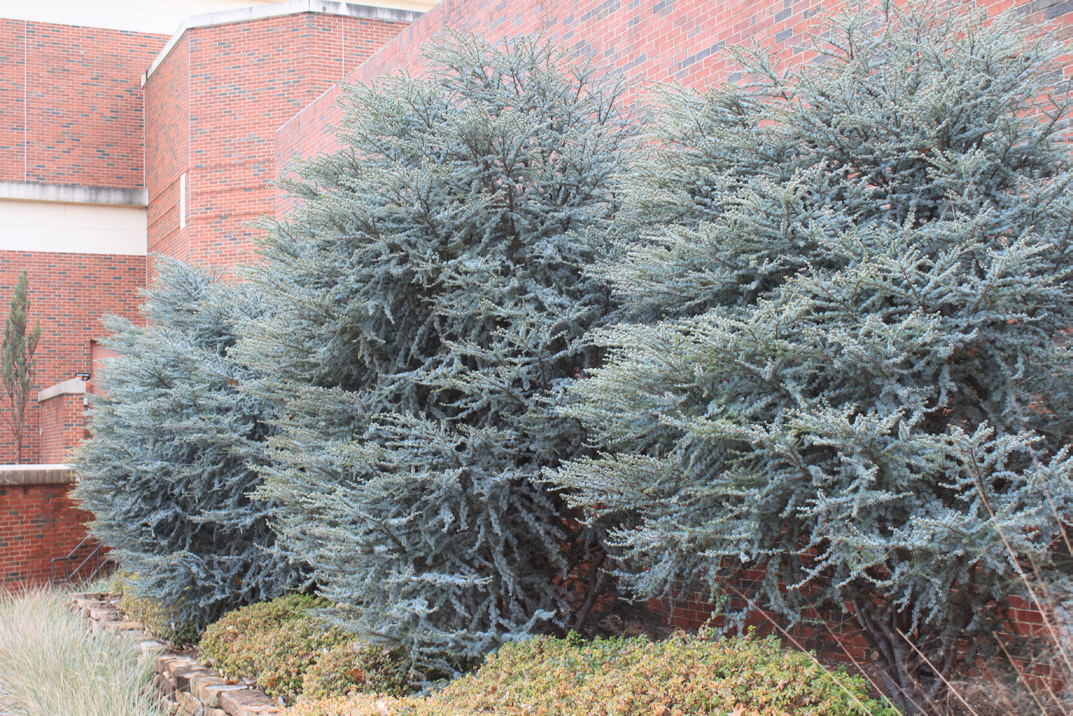
- Cedar, Atlas (Cedrus atlantica)
- Cedar, Deodar (Cedrus deodara)
- Cedar, Lebanon (Cedrus libani)*
- Cherrylaurel, Carolina (Prunus caroliniana)
- Cypress, Arizona (Cupressus arizonica)
- Cypress, Italian (Cupressus sempervirens)*
- Holly (Ilex spp.)
- Junipers (Juniperus spp.)
- Pine, Austrian (Pinus nigra)
- Pine, Japanese Black (Pinus thunbergiana)
- Pine, Limber (Pinus flexilis)
- Pine, Pinyon (Pinus edulis)*
- Pine, Ponderosa (Pinus ponderosa)
- Redcedar, Eastern (Juniperus virginiana)
- Waxmyrtle, Southern (Morella cerifera)
Tolerates or Prefers Wet Locations
Although plants listed below may tolerate or prefer wet locations, they only tolerate flooding for short periods of time (normally only a few days). Very few will actually survive long-term submersion of their root system. Pictured below is the Yaupon holly (Ilex vomitoria).
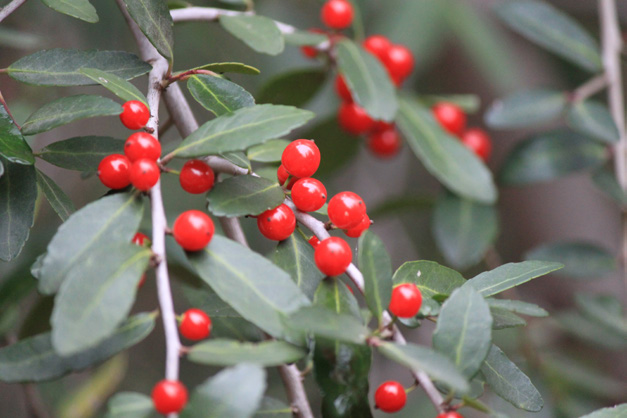
- Arborvitae, American or Eastern (Thuja occidentalis)
- Arborvitae, Giant or Western Redcedar (Thuja plicata)
- Holly, American (Ilex opaca)
- Holly, Yaupon (Ilex vomitoria)
- Magnolia, Southern (Magnolia grandiflora)
- Magnolia, Sweetbay (Magnolia virginiana)*
- Oak, Live (Quercus virginiana)*
- Pine, Loblolly (Pinus taeda)
- Waxmyrtle, Southern (Morella cerifera)
Tolerates or Prefers Shade
The following plants will perform well with shady conditions. Pictured below is the Cherrylaurel (Prunus laurocerasus).
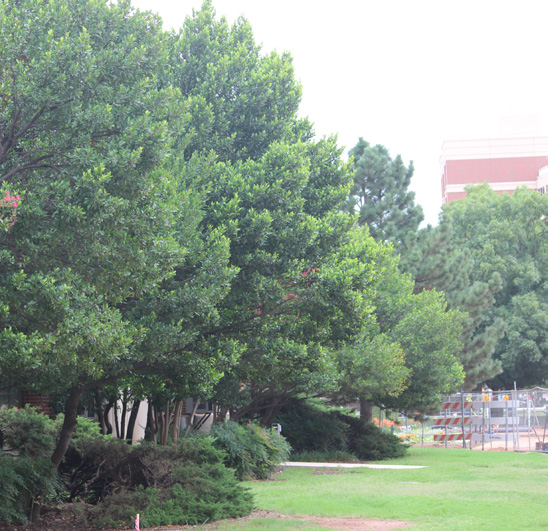
- Cherrylaurel, Caroline (Prunus caroliniana)
- Cherrylaurel (Prunus laurocerasus)
- Falsecypress, Alaska-cedar or Nootka (Chamaecyparis nootkatensis)*
- Holly (Ilex spp.)
- Magnolia, Southern (Magnolia grandiflora)
- Magnolia, Sweetbay (Magnolia virginiana)*
- Pine, Mugo (Pinus mugo)
- Spruce, Colorado (Picea pungens)
- Waxmyrtle, Southern (Morella cerifera)
Tolerates or Prefers Alkaline Soils
Many of the plants listed below will thrive and remain
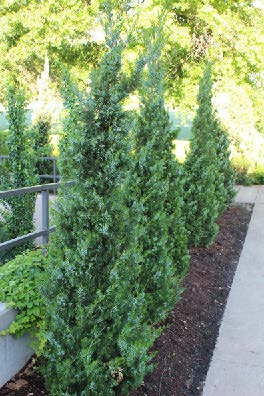
green despite growing in high pH soil. However, when pH values exceed pH 8.5 or higher, it may be difficult to culture some of the species below. Pictured is the Eastern redcedar cultivar (Juniperus virginiana)
- Arborvitae (Thuja spp.)
- Cherrylaurel, Carolina (Prunus caroliniana)
- Holly, Yaupon (Ilex vomitoria)
- Juniper (Juniperus spp.)
- Pine, Mugo (Pinus mugo)
- Pine, Pinyon (Pinus edulis)
- Pine, Ponderosa (Pinus ponderosa)
- Waxmyrtle, Southern (Morella cerifera)
Tolerates Salty Soils
These species are known to tolerate soils with varying
levels of salt content in which other evergreens would not survive. Growth and overall performance will likely be compromised in a sodic (high salt content) soil. Pictured is the Austrian pine tree (Pinus nigra).
- Cherrylaurel, Carolina (Prunus caroliniana)
- Cypress, Leyland (X Cupressocyparis leylandii)
- Falsecypress, Hinoki (Chamaecyparis obtusa)*
- Holly, Yaupon (Ilex vomitoria)
- Juniper, Chinese (Juniperus chinensis)
- Magnolia, Southern (Magnolia grandiflora)
- Pine, Austrian (Pinus nigra)
- Pine, Bosnian (Pinus heldreichii)
- Pine, Japanese Black (Pinus thunbergii)
- Pine, Loblolly (Pinus taeda)
- Pine, Mugo (Pinus mugo)
- Pine, Scots or Scotch (Pinus sylvestris)
- Pine, Short Leaf (Pinus echinata)*
- Pine, Slash (Pinus elliottii)*
- Oak, Live (Quercus virginiana)
- Redcedar, Eastern (Juniperus virginiana)
- Spruce, Dwarf Alberta (Picea glauca 'Conica')
- Spruce, Colorado (Picea pungens)
- Waxmyrtle, Southern (Morella cerifera)
Ornamental Interest
Many plants have ornamental merit in addition to the function they provide, characteristics that set them above all other. For example, the exquisite bark colors and textures of lacebark pine, the colorful fruit of the hollies that persist into winter and the unusual and picturesquely gnarled branching habit of escarpment live oak all have outstanding ornamental value. Many species included in this publication also have cultivars with blue or golden foliage or have weeping, columnar or fastigiate forms.
Showy Bark, Branches, Foliage or Unusual Form
Pictured is the Threadleaf American arborvitae (Thuja occidentalis 'Filiformis') tree.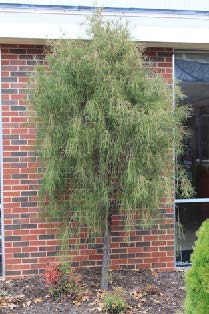
- Arborvitae (Thuja and Platycladus spp.) golden and blue foliage forms, columnar and threadleaf forms
- Cedar, Atlas (Cedrus atlantica) Golden, blue and weeping forms
- Chinafir (Cunninghamia lanceolata)* interesting foliage and bark on mature plants
- Cypress, Arizona (Cupressus arizonica) blue, golden and weeping forms
- Cypress, Italian (Cupressus sempervirens)* fastigiated, golden forms
- Holly (Ilex spp.) variegated and weeping forms
- Incensecedar, California (Calocedrus decurrens)* interesting bark.
- Oak, Escarpment Live (Quercus fusiformis) picturesque branching structure
- Pine (Pinus spp.) blue, gold, weeping and columnar forms
Interesting or Showy Fruit
Pictured is a Southern Magnolia seed pod.
- Cherrylaurel, Carolina (Prunus caroliniana)
- Cypress, Arizona (Cupressus arizonica)
- Holly (Ilex spp.)
- Juniper (Juniperus spp.)
- Magnolia, Southern (Magnolia grandiflora)
- Pines (Pinus spp.)
- Waxmyrtle, Southern (Morella cerifera)
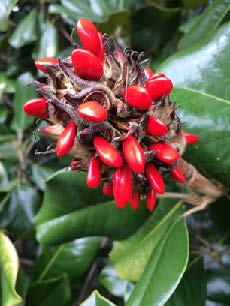
Specimens, Groupings, Screens and Groves
In many landscapes, a grouping of three or more needle or broadleaf evergreens provides
both visual privacy and a more aesthetically pleasing feeling than tightly pruned
hedges. When positioning these trees, be sure to provide them with ample space to
spread. Pictured is the Teddy Bear® Southern Magnolia (Magnolia grandiflora 'Southern Charm') tree. 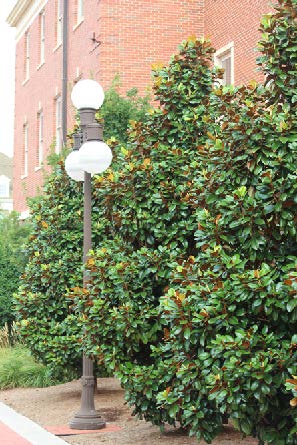
- Arborvitae (Thuja and Platycladus spp.)
- Cherrylaurel (Prunus laurocerasus)
- Cherrylaurel, Carolina (Prunus caroliniana)
- Chinafir (Cunninghamia lanceolata)*
- Cypress (Cedrus spp.), (x Cupressocyparis spp.)* and (Cupressus spp.)*
- Falsecypress (Chamaecyparis spp.)*
- Holly (Ilex spp.)
- Incensecedar, California (Calocedrus decurrens)*
- Juniper (Juniperus spp.)
- Magnolia, Southern (Magnolia grandiflora)
- Pines (Pinus spp.)
- Waxmyrtle, Southern (Morella cerifera)
Use Under Power Lines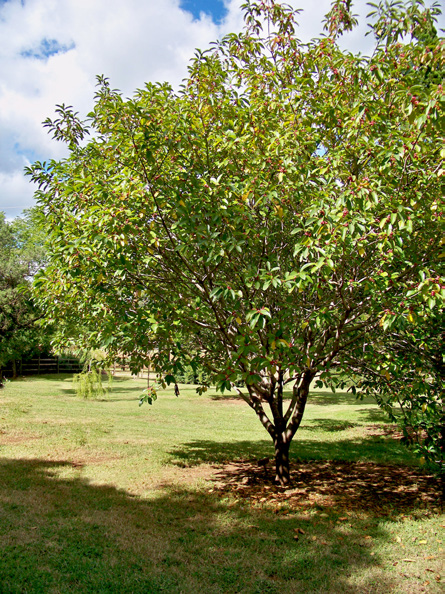
Just a few of many possible plants for use under power lines are listed below. All will be slow to reach a height as to interfere with overhead lines. Again, some plants below have the genetic potential over many years to actually reach power lines. Don't forget to select dwarf cultivars in any species for growing under such structures. Pictured is the Carolina Cherrylaurel (Prunus caroliniana) tree.
- Cherrylaurel, Carolina (Prunus caroliniana)
- Falsecypress (Chamaecyparis spp.)*
- Holly (Ilex spp.)
- Juniper (Juniperus spp.)
- Magnolia Southern (dwarf selections) (Magnolia grandiflora)
- Pine, Mugo (dwarf forms) (Pinus mugo)
Street and Urban Planning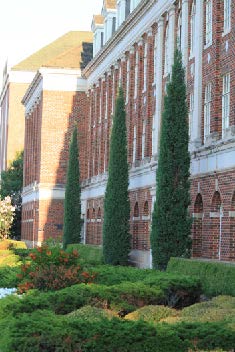
The following plants adapt exceptionally well to a variety of environmental and/or urban stresses, such as heat, drought and compacted, infertile soil. Pictured is the Taylor juniper (Juniperus virginiana 'Taylor') tree.
- Arborvitae, Oriental (Platycladus orientalis)
- Chinafir (Cunninghamia lanceolata)*
- Cypress, Arizona (Cupressus arizonica)
- Holly (Ilex spp.)
- Juniper (Juniperus spp.)
- Oak, Live (Quercus virginiana)*
- Waxmyrtle, Southern (Morella cerifera)
Attract Wildlife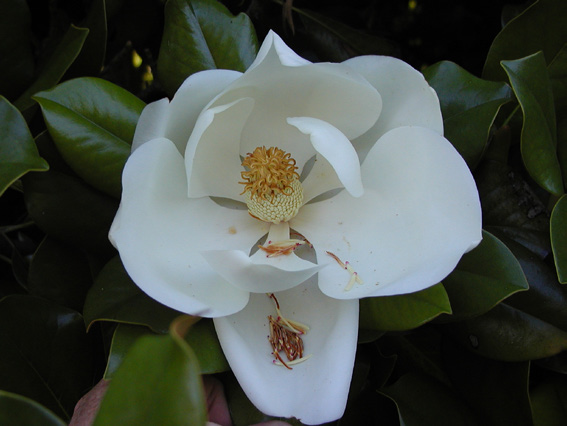
Many gardeners not only enjoy plants in the landscape, but also the wildlife that may be attracted to them. The following plants may attract wildlife by the fruits they produce or by providing physical protection. Pictured is a Southern Magnolia flower and an Escarpment Live Oak acorn.
- Cherrylaurel, Carolina (Prunus caroliniana)
- Holly (Ilex spp.)
- Magnolia, Southern (Magnolia grandiflora)
- Magnolia, Sweetbay (Magnolia virginiana)*
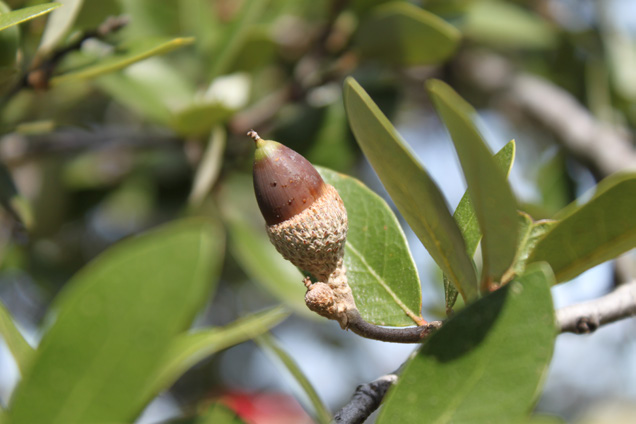
- Oak (Quercus virginiana and Q. fusiformis)
- Pine (Pinus spp.)
- Redcedar, Eastern (Juniperus virginiana)
- Waxmyrtle, Southern (Morella cerifera)
Native Species
Native in this context is being defined as any plant native to somewhere in the continental
United States, not just Oklahoma. Pictured is an Escarpment Live Oak tree.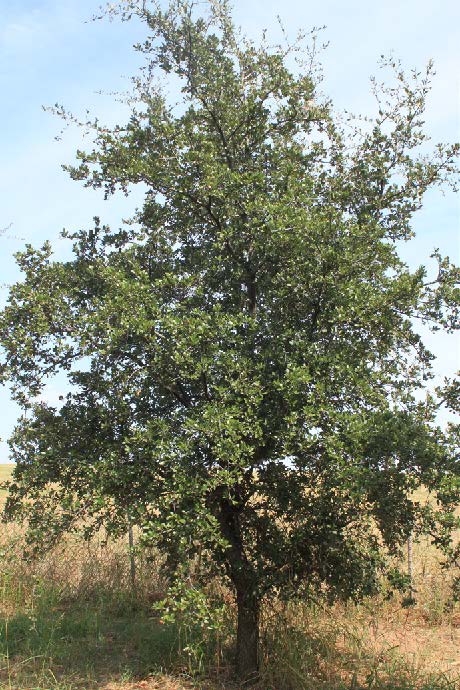
- Arborvitae, American or Eastern (Thuja occidentalis)
- Arborvitae, Giant Western Redcedar (Thuja plicata)
- Cherrylaurel, Carolina (Prunus caroliniana)
- California Incensecedar (Calocedrus decurrens)*
- Cypress, Arizone (Cupressus arizonica)
- Holly, American (Ilex vomitoria)
- Holly, Yaupon (Ilex vomitoria)
- Juniper, Eastern Redcedar (Juniperus virginiana)
- Juniper, Rocky Mountain (Juniperus scopulorum)
- Magnolia, Southern (Magnolia grandiflora)
- Magnolia, Sweetbay (Magnolia virginiana)
- Pine, Eastern White (Pinus strobus)*
- Pine, Limber (Pinus flexilis)*
- Pine, Loblolly (PInus taeda)
- Pine, Pinyon (Pinus edilis)*
- Pine, Short Leaf (Pinus echinata)*
- Pine, Slash (PInus elliottii)*
- Pine, Southwestern White (Pinus strobiformis)*
- Pine, Virginia (Pinus virginiana)*
- Oak, Live (Quercus virginiana)*
- Oak, Escaprment Live (Qercus fusiformis)*
- Waxmyrtle, Southern (Morella cerifera)
Tree Selection Guide*
- Mature height (MHt) will vary considerably by cultivar and site and is shown here assuming adequate care: Low: less than 20 feet; Medium: 20 feet to 40 feet; and High: more than 40 feet.
- Growth rate (GR) refers to height growth for the first 10 years after a tree is planted and is shown as follows: Low: less than 12 inches per year; Medium: 12 inches to 24 inches per year; and High: more than 24 inches per year.
- Region refers to the area of Oklahoma in which the plant grows best. (I-35 delineation between E and W and I-40 between N and S)
- NW - Northwest
- SW- Southwest
- NE - Northeast
- SE - Southeast
- P - Panhandle
- A - All regions
Table 1. Evergreen Trees
| Needle/Scale Evergreens | Region | GR | MHt | Comments |
|---|---|---|---|---|
| Arborvitae, American or Eastern (Thuja occidentalis) | A | M | M | Numerous cultivars available. Should be planted in deep, well-drained soil; once established, will tolerate heat and drought. Susceptible to strong winds, ice and snow. Good for hedges, screens, specimen. |
| Arborvitae, Giant or Western Redcedar (Thuja plicata) | NE, SE | S-M | H | Prefers moist, well-drained, fertile soils. In the wild, it grows near rivers and swamps, even found in bogs; pH adaptable. Growth will be stunted on dry soils. |
| Arborvitae, Oriental (Platycladus orientalis) | NE, NW, SE, SW | L | M | Tolerant of most soils except those that are extremely wet; pH adaptable. Good for hedges and specimens. Many cultivars. Hardier species for the south. |
| Cedar, Atlas (Cedrus atlantica) | A | M | H | Primarily used as a specimen tree. Good substitute for Colorado spruce. Blue and weeping forms available. Semi-dwarf forms like ‘Horstmann’ which is slow growing, reaching 8 feet to 10 feet tall and 5 feet to 6 feet wide also are available. |
| Cedar, Deodar (Cedrus deodara) | NE, SE | M | H | Less cold hardy than atlas cedar. Full sun, should be protected from sweeping winds. Moderate degree of drought tolerance. |
| Cedar, Lebanon (Cedrus libani) (Cedrus libani var. stenocoma) | NE, NW, SW, SE | S | H | Drought tolerant once established. Intolerant of poorly drained, wet soils. Best winter hardiness of the true cedars. Site trees in locations protected from winter winds. |
| Chinafir (Cunninghamia lanceolata) | NE, SE | L | H | Prefers, moist, acidic, well-drained soils. Grows best in open spaces shaded by trees and protected from windswept sites. |
| Cypress, Arizona (Cupressus arizonica) | NE, SE, NW, SW | M | H | Requires well-drained soil and thrives in hot, dry environments. Foliage can be gray-green, blue and recently, yellow foliage. As the tree ages, the bark exfoliates beautifully, becoming mottled with patches of burnt orange and green. Will grow well as far north as Woodward. |
| Cypress, Italian (Cupressus sempervirens) | SE, SW | M | M | Columnar 30 feet tall by 2 feet wide. Sun to part shade. Stunning bark on older trees. Susceptible to bagworms and mites. Best grown in southern Oklahoma due to sensitivity to cold. |
| Cypress, Leyland (X Cupressocyparis leylandii) | NW, SW | H | H | Loam to clay loam. Feathery foliage. Grows to 50 feet tall and 30 feet wide. Canker diseases can be a problem. |
| Falsecypress, Alaska-cedar or Nootka (Chamaecyparis nootkatensis) | NE, SE, NW | M | H | Full sun. Bagworms and mites can be problems. |
| Falsecypress, Hinoki (Chamaecyparis obtusa) | NE, SE | M | H | Best in full sun; prefers moist, fertile soil. Shelter from hot wind and afternoon sun. |
| Falsecypress, Japanese (Chamaecyparis pisifera) | NE, SE | M | H | Loam soils. Part sun. Shelter from hot wind and afternoon sun. |
| Incensecedar, California (Calocedrus decurrens) | NE, SE, NW, SW | S-M | H | Prefers moist, well-drained, fertile soil; but it shows good adaptability to different soil types, tolerates poor soils. Very drought and heat tolerant when established. Not tolerant of wind-swept areas. Handsome specimen for large areas. |
| Juniper, Eastern Redcedar (Juniperus virginiana) | A | M | M | Many cultivars to choose from. Full sun, drought tolerant. Has become a weed for ranchers, but makes good windbreak. Co-host for cedar-apple rust disease. See local garden centers for appropriate varieties. |
| Juniper, Rocky Mountain (Juniperus scopulorum) | P, NW, SW | M | M | Many cultivars. Susceptible to phomopsis blight east of I-35 highway. |
| Pine, Afghan (Pinus eldarica) | NW, SW | H | H | Fast-growing, pine suitable for alkaline soils. Good for windbreak. Pine tip moth can kill new shoots and ruin shape. Won’t tolerate wet sites. |
| Pine, Aleppo (Pinus halapensis) | NW, SW | M | H | Light green needles and irregular growth habit. Native to the Mediterranean. Used as a specimen or as windbreak or screen. Drought and alkaline tolerant. |
| Pine, Austrian (Pinus nigra) | A | M | H | Very drought tolerant. Full sun. Well to moderately drained soil. Can be affected by diplodia tip blight and the devastating pine wood nematode disease. |
| Pine, Bosnian (Pinus heldreichii) | A | L | M | Slow-growing with a dense pyramidal form when young; reaches only 25 feet to 30 feet in the landscape. Young cones are purple, turning brown as they mature. Seed is edible. Prefers full sun and once established is tolerant of high pH soils and drought. Used in areas where space is limited. Occasional pine wood nematode disease. |
| Pine, Eastern White (Pinus strobus) | NE, SE | H | H | Loam soil. Protect from hot wind and drought. Soft needles. Full sun to part shade. |
| Pine, Italian Stone (Pinus pinea) | SW, SE | M | M | Develops umbrella shaped crown with age. Drought tolerant and tolerant of wide range of soils. |
| Pine, Japanese Black (Pinus thunbergii) | NE, SE, SW | M | M | Looks like Austrian pine. Loam to clay. Tolerates salty soils. Freezes back to soil in northwest Oklahoma. Very susceptible to pine wood nematode. |
| Pine, Japanese Red (Pinus densiflora) | A | M | H | Sun to part shade. Loam to clay loam. Many stems, orange with age. Shelter from cold northwest winter wind. Very susceptible to pine wood nematode. |
| Pine, Lacebark (Pinus bungeana) | A | L | H | Prefers well-drained soil in sunny location. Interesting exfoliating bark. |
| Pine, Limber (Pinus flexilis) | A | L | M | Better north than south. Nematode resistant. Well-drained moist soil. Flexible limbs. Five-needled tree gives it a nice soft texture. Blue-needled forms available. |
| Pine, Loblolly (Pinus taeda) | NE, SE, NW, SW | H | H | Loam to clay loam. Sun to part shade. Southeast U.S. forest pine, thus do not make suitable specimen or windbreak plants. Pine tip moth may be a problem when young. |
| Pine, Mugo (Pinus mugo) | A | L | L | Loam to clay loam. Full sun. Better adapted north of I-40. |
| Pine, Pinyon (Pinus edulis) | P, NW, SW | L | M | Compact to 30 feet. Excellent for panhandle. Sandy loam, full sun. Well-drained soil, tolerates dry, poor, alkaline soils, but not wet soils. Best not to irrigate much after it is established in the landscape. Edible nuts. |
| Pine, Ponderosa (Pinus ponderosa) | A | M | H | Very drought and wind tolerant. Well-drained loam to rocky soil. Full sun. Pine tip borer may be a problem when tree is young. |
| Pine, Red or Norway (Pinus resinosa) | A | M | H | Well-drained soil. Full sun. Better adapted north of I-40. Pine tip borer when young. |
| Pine, Scots or Scotch (Pinus sylvestris) | A | M | H | Common Christmas tree. Compact forms are available. Pine tip moth when young. Very susceptible to pine wood nematode. Loam to clay loam. |
| Pine, Short Leaf (Pinus echinata) | SE | L | H | Fairly drought tolerant. Does well in drier, rocky, upland soils. Very picturesque with age. |
| Pine, Slash (Pinus elliottii) | SE | H | H | Loam to clay loam. Sun to part shade. Southeast U.S. forest pine, thus do not make suitable specimen or windbreak plants. Pine tip moth a problem when young. |
| Pine, Southwestern White (Pinus strobiformis) | A | M | M | Loam soil. Full sun to part shade. Plants grow well in Stillwater, OK, and Wichita, KS. Grows to 80 feet tall in New Mexico and southwest U.S. |
| Pine, Virginia (Pinus virginiana) | A | L | M | Not very ornamental. Grown for Christmas tree industry. Very susceptible to pine tip borer. Clay loam to sandy loam. |
| Spruce, Dwarf Alberta (Picea glauca ‘Conica’) | P, NW | L | L | Compact to about 10 feet in 30 years. Spider mites can be a problem in hot weather. Better adapted to northern portions of Oklahoma. Locate in area protected from dry winds and late, hot sun. Does best in sandy loam soil with adequate irrigation. |
| Spruce, Colorado (Picea pungens) | P, NW, NE | L-M | M-L | Colorado spruce is a popular landscape plant because of its uniform shape and blue needled forms; however, it is not well suited for the heavy clay soils, heat and humidity. Best in northwest and panhandle. |
| Spruce, Norway (Picea abies) | NE | H | H | Grows best in cool climates and average, acidic, evenly moist, well-drained soil in full sun. |
| Broadleaf Evergreens | ||||
| Cherrylaurel, Carolina (Prunus caroliniana) | A | H | M | Good for screens, background plant and as small patio tree. Tolerant of drought and alkaline soil. Fragrant flowers and attractive fruit attract bees and wildlife. |
| Cherrylaurel (Prunus laurocerasus) | A | H | L | Large shrub or small tree. Tolerant of alkaline soils, dry and poor soils, pollution and heavy pruning. |
| Holly, American (Ilex opaca) | NE, SE | L | M | Produces colorful red fruits that persist through winter (need male selection for improved fruit development). Well-drained, acid soils. Sun to part shade. Leaves have spines. Foliage is not glossy. Medium drought tolerance, mulch. Much variation by species and cultivars. Most are tree-like from 20 feet to 30 feet tall by 12 feet to 20 feet wide. |
| Holly, Foster (Ilex x attenuata ‘Fosteri’) | A | L | M | Produces colorful red fruits that persist through winter (need male selection for improved fruit development). Best in area protected from winter winds. Full sun to part shade. Typically grows to a mature height of 20 feet to 30 feet tall with a spread of 10 feet to 15 feet unless pruned |
| Holly, Yaupon (Ilex vomitoria) | A | H | L | Shrub or small tree native to the eastern U.S. Female shrubs produce red drupes in fall if fertilized. The plant will form thickets unless suckers are removed. Plant in average well-drained soils in sun to shade. It is tolerant of a wide range of soil types and can withstand both drought and occasional flooding. |
| Magnolia, Southern (Magnolia grandiflora) | NE, SE, NW, SW | M | H | Grow to 50 feet to 60 feet tall and 30 feet to 50 feet wide. Should be given adequate space for growth. Large white fragrant flowers. Avoid hot dry windy sites. Mulch, water and fertilize. Not drought tolerant. Remove narrow forks, but don’t over prune. Dwarf cultivars like Teddy Bear® are available. |
| Magnolia, Sweetbay (Magnolia virginiana) | NE, SE | M | M | Eastern native. Features cup-shaped, sweetly fragrant (lemony), creamy white, waxy flowers in mid-spring, sometimes blooming sporadically throughout the summer. Shiny green foliage is silvery beneath. Evergreen to semi-evergreen in the South. Cone-like fruits with bright red seeds mature in fall and can be showy. Can become chlorotic in alkaline soils. |
| Oak, Live (Quercus virginiana) | NE, SE | M | M | Not cold hardy in most of Oklahoma. Best grown in the extreme southern regions of the state. Escarpment live oak is more suitable for the western part of the state. |
| Oak, Escarpment Live (Q. fusiformis) | A | L | M | Smaller version of the coastal live oak (Q. virginiana) with picturesquely gnarled branches and evergreen leaves. Native to southern Oklahoma, drought and cold tolerant. Long-lived shade tree for smaller, urban landscapes. Great wildlife tree. |
| Palm, Needle (Rhapidophyllum hystrix) | SE | H | L | A shrubby, clumping, nearly trunkless, fan palm that grows to 3 feet to 6 feet tall and as wide. Native to moist to wet woodlands, slopes, ravines and stream bottomland in the southeastern U.S. |
| Palm, Windmill (Trachycarpus fortunei) | SE, NE | L | L | Palm tree with attractive, compact crown with large, stiff, fan-like, green foliage and distinctive hairy black fibers covering its slender, graceful trunk. Great for small gardens. |
| Waxmyrtle, Southern, Southern Bayberry (Morella cerifera) | NE, SE | H | L | Thrives in full sun to part shade. Tolerates wide range of soil conditions and seems to tolerate poorly drained soils. |
*Note: many other evergreens have been grown successfully on occasion in Oklahoma when provided the proper microenvironment, including, but not limited to species in the genera Abies, Cryptomeria, Podocarpus, Pseudotsuga, Sequoia, Tsuga and tree-type Yucca.
